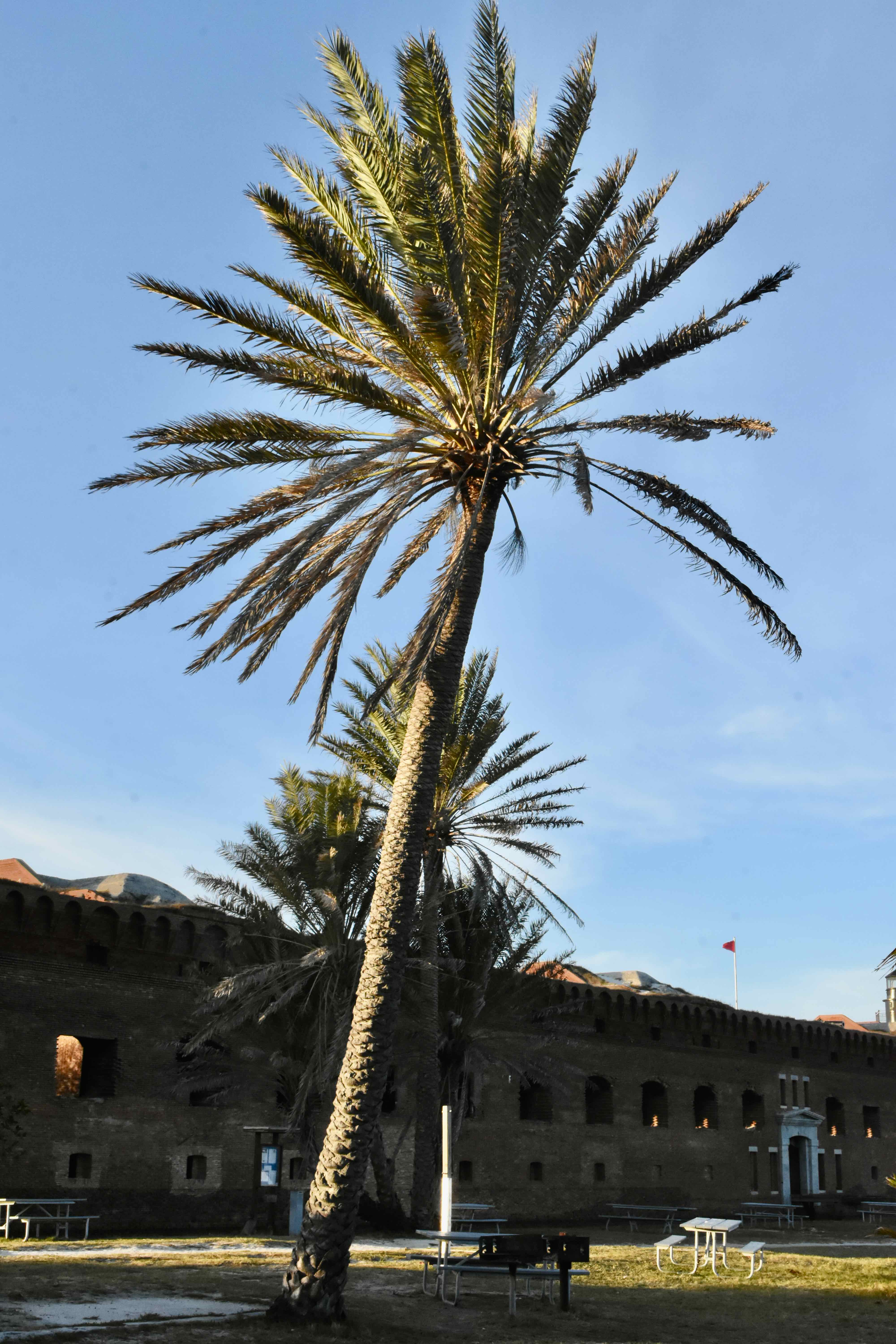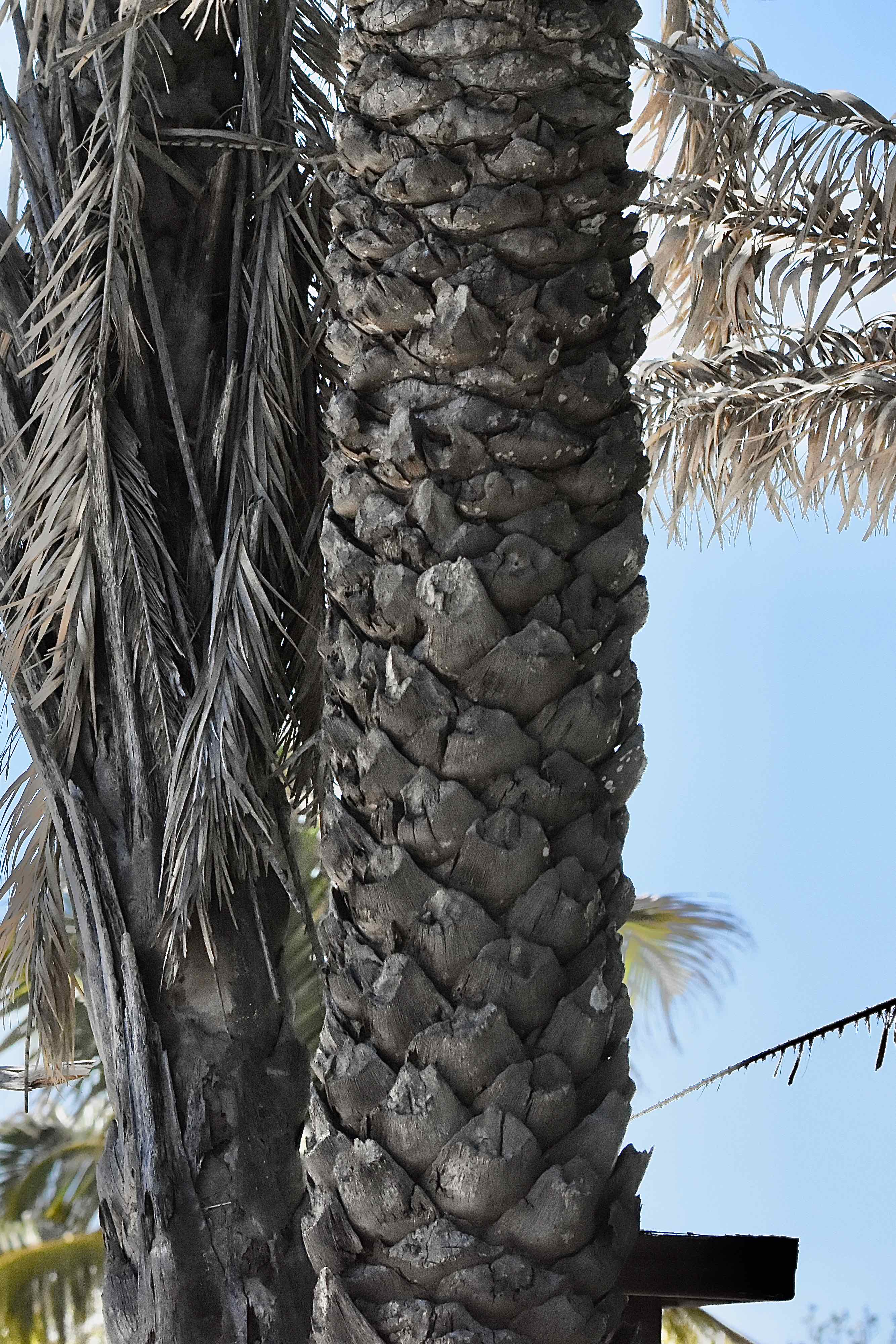
African date palm photographed at Fort Jefferson, Garden Key, Dry Tortugas National Park, Monroe County, in April 2017.
There are few plants as culturally important as the African date palm, Phoenix dactylifera. In parts of the world, it’s fed millions of people for thousands of years, used to greet victorious armies and symbolically important to two major religions.
In South Florida, however, it’s merely a graceful addition to the landscape. African date palms will grow here, thrive to an extent, but our humid climate limits its usefulness here.
African date palms are absolutely massive, able to grow to 80 feet tall and even approach 100 feet, the length of the trunk marked with “boots” where fronds once joined. Its fronds can be as long as 20 feet with leaflets as long as two feet. Its inflorescences, or flower stalks, can be as long as two feet. Its leaflets come to a sharp, needle-like point.
The fruit, technically called a drupe, goes from green to yellow to reddish brown when fully ripe. Each contains a single seed. A single bunch can contain more than 1,000 dates; a single tree can produce as much as 150 pounds in a year.
It should be noted that African date palms are dioecious, meaning male and female flowers are borne on separate trees. One of each is necessary to produce fruit. Also noteworthy here: African date palms are wind-pollinated, though there could be some insect interaction as well.
It will grow in regions where temperatures don’t dip below 15 degrees, but to produce commercial quality fruit in quantity, it needs a dry climate, which rules out our part of the globe. It’s heat and drought-resistant, but at the same time, it needs to be near water.
African date palms have been cultivated for so long that its native range, where it originated, is uncertain. North Africa and the Middle East are obvious candidates, but over thousands of years, it’s been exported as far away as India.
The Spanish first brought the African date palm to the new world, Peru and Baja, California. Noted plant explorer David Fairchild of Fairchild Tropical Botanic Garden fame played a part in modern efforts to bring the tree to the United States during the late 19th and early 20th century. Seeds can’t be used to grow commercial quality fruit; instead, suckers are cut off from a mature tree and transplanted.
One Walter T. Swigle traveled to Algeria in 1900 and acquired eight tons of date palm suckers to bring back to the U.S. In the intervening decades commercial African date palm groves have been established in the dry heat of Arizona and California, and the U.S. has become a major producer of dates.
Oddly, the USDA’s PLANTS Database only shows African date palms growing in the wild (naturalized) in the two western states but not Florida. The Institute for Regional Conservation, however, lists naturalized date palms growing in 23 South Florida parks and preserves. Just to note that the USDA bases its data on vouchered, or scientifically verified, specimens growing in the wild and not cultivated specimens.
Records of date cultivation, uh, date back to at least 4,000 B.C. in Mesopotamia. Cultivation of dates goes back at least a few thousand year more. Trade routes developed around date production.
As we noted at the top. Every part of the tree has its uses: the wood and leaves are used as timber for construction and fabric for houses, fences and furniture.
The leaves are used to make ropes cord, baskets and even furniture. Other parts are used as fuel. The fruit is eaten out of hand but also is used to make vinegar, chutney and a variety of baked goods and other dishes. The heart of palm is used in salads.
In places, unripe fruit is used for health purposes; the fronds have religious and cultural significance (the palms of Palm Sunday, for example). Date palms are mentioned multiple times in both the Bible and the Qur’an. Dates are among the first foods consumed to after sundown during the Islamic holiday of Ramadan. Victorious armies used fronds as a symbol of their conquests.
As to the meaning and origin of it scientific name, we’re all familiar with the Phoenix, the mythical bird that rises from the ashes. The Phoenix nests at the top of a date palm, where is he is eventually consumed and reborn. It’s believed that the name derives from the Greek word for red. The Phoenix bird is both yellow and red as are dates as they ripen.
Dactylifera is a mashup of Greek and Latin words meaning finger-bearing, a reference to the clusters of fruit hanging from the tree like fingers.
African date palms are members of Aracaceae, the palm family.
Dry Tortugas National Park



